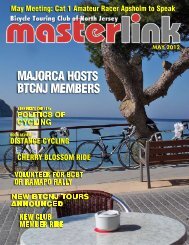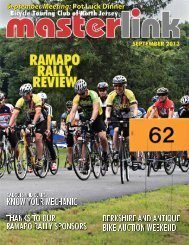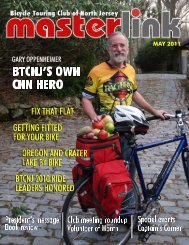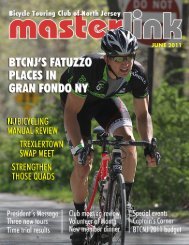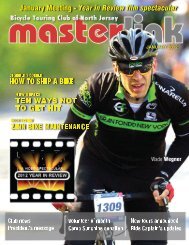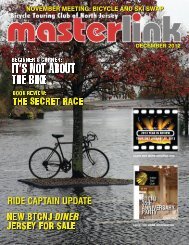2President’s MessageSometimes a Cigar is Just a Cigarat <strong>the</strong> bit to help out.I know. You're thinking, what in <strong>the</strong> worlddoes this have to do with cycling? Patience.There is always a connection. No, it hasnothing to do with Sigmund Freud or BillClinton for that matter. Picture this. Acyclist is enjoying a leisurely ride on a quietEthan Brook meandering road. There were o<strong>the</strong>r cyclistsa short distance in front <strong>of</strong> him. He could see a car approaching. Thedriver seemed to be yelling and pointing at <strong>the</strong> riders as he approached<strong>the</strong>m. As he got closer he could hear <strong>the</strong> driver yelling PIG,PIG, PIG! As <strong>the</strong> car passed our rider, <strong>the</strong> biker turned around, flippedhis middle finger at <strong>the</strong> driver - and that's when he hit <strong>the</strong> pig. Is<strong>the</strong>re a moral to this story. Probably many. I'll go with, "sometimes apig is just a pig."Now, <strong>the</strong> news. Our biggest and most important club event, <strong>the</strong>Ramapo Rally is just around <strong>the</strong> corner. We are still in need <strong>of</strong> morevolunteers . We are a club <strong>of</strong> 1,531 members. Many <strong>of</strong> you are newmembers. This would be a great opportunity to pitch in and participatein a great event. You will be rewarded wtih lots <strong>of</strong> new friends,and a spiffy volunteer tee shirt. How can you top that? To get one<strong>of</strong> those lucky volunteer slots, send an e-mail to Steve Greenbergsteve551@optonline.net, and let him know that you are chompingLetters to <strong>the</strong> EditorHistory tells us that, in 1783, George Washington invited his <strong>of</strong>ficersto Fraunces Tavern in New York City and bid <strong>the</strong>m farewell. Now,many people have told me that I closely resemble <strong>the</strong> fa<strong>the</strong>r <strong>of</strong> ourcountry – honesty, bravery, wooden teeth, and all. However, I willnot be following that particular example, as history also tells us thatGeorge was stuck with <strong>the</strong> bill for <strong>the</strong> dinner!But I would like to say farewell, as Sue and I leave New <strong>Jersey</strong> forSouth Carolina in two months’ time. We are giving up good pizza toget good shrimp and grits. I am giving up trying to dodge squirrelscrossing <strong>the</strong> road while riding my bike to evading alligators whileriding my bike. We are leaving <strong>the</strong> 7th-ranked bicycle friendly statefor <strong>the</strong> 32nd! Oh, noooooo!Over <strong>the</strong> past years, I have enjoyed riding and working with you,BTCNJ 2012 OFFICERSPRESIDENT • Ethan Brook ethanbrook@gmail.comVICE-PRESIDENT • Ralph Monti ralphm@mediaconsults.comSECRETARY • Diane McNally dmmcnally@optonline.netRIDES CAPTAIN • Wade Wegner w.a.wegner@gmail.comMEMBERSHIP • Terry Griffin info@btcnj.comLEGISLATIVE ACTION • Ted Semegran ted_semegran@hotmail.comMASTERLINK • Larry Schwartz btcnj.masterlink@gmail.comWEBMASTER • Thomas Hobbick webmaster@btcnj.comTOURS • Barbara Augenblick beejayaug@gmail.comVOLUNTEER DEVELOPMENT Steve Greenberg steve551@optonline.netSPECIAL EVENTS • Linda Krauss krauski@gmail.com andDiana Shikiar dianashikiar@gmail.comPUBLICITY • Joel Ringer ringer@teammarketingsvc.comTREASURER • Joe Montigelli josephmonti@yahoo.comIf you prefer just doing a ride, no problem. There are six rides tochoose from. You can ride on your own, or join one <strong>of</strong> <strong>the</strong> manygroup rides. Did I mention food? There’s lots <strong>of</strong> food to keep younourished during <strong>the</strong> ride, and plenty <strong>of</strong> food and drinks at <strong>the</strong> end<strong>of</strong> <strong>the</strong> ride as well. What a deal! I'm beginning to sound like an infomercial.And if you register now you will receive a - never mind. Justcheck out <strong>the</strong> website to register.Last item. How about those Kenyans? There was an interestingarticle in <strong>the</strong> New York Times on June 21st. Not only do <strong>the</strong>y have<strong>the</strong> fastest long distance runners in <strong>the</strong> world, now <strong>the</strong>y are readyto challenge <strong>the</strong> cycling world. This July <strong>the</strong>y will be participating in<strong>the</strong> L'Etape du Tour, which covers two legs <strong>of</strong> <strong>the</strong> Tour de France. Lastyear two riders finished in <strong>the</strong> top 20 out <strong>of</strong> 10,000 riders. The articleclosed with <strong>the</strong> following comment: "Everywhere you can run. As forcycling, I don't think it can become one <strong>of</strong> <strong>the</strong> main sports <strong>of</strong> Kenya,or in Africa. The first thing is <strong>the</strong> roads. The roads are terrible, andpeople drive crazy." Welcome to New <strong>Jersey</strong>.Have a great summer. Enjoy <strong>the</strong> rides. And above all ride safely. Seeyou on <strong>the</strong> road.-Ethan Brook, Presidentand have enjoyed serving <strong>the</strong> club as Vice President, President, PastPresident, Past Past President, etc. It’s been interesting, instructive,sometimes trying, but always fun! We are relocating to Bluffton, SC,which is just about 25 miles north <strong>of</strong> Savannah, GA, so you may nothave seen <strong>the</strong> last <strong>of</strong> me. After all, it’s just a short ride down to <strong>the</strong>start site <strong>of</strong> Ted Semegran’s Florida rides...I’m also giving up my position as Executive Director <strong>of</strong> <strong>the</strong> New <strong>Jersey</strong>Bike & Walk Coalition, but have already sent <strong>of</strong>f my membershipcheck to <strong>the</strong> Palmetto Cycling Coalition – so my bike advocacy andbike education work, which means so much to me, will continue.I wish you all great rides over <strong>the</strong> coming years. You have a wonderfulbicycle club, and if you are not already involved to help run it, Iurge you to do that. And if you are ever down in <strong>the</strong> Bluffton area,just over <strong>the</strong> bridge from Hilton Head, get in touch. The best e-mailaddress to use would be jimnichlci@gmail.com.A list <strong>of</strong> people to thank would be very long, too long for <strong>the</strong> Master-Link. But a special “thank you” to both Gene Marsh and Bob DeMair,who gave me such great guidance along <strong>the</strong> way. See you on <strong>the</strong>road – but watch out for <strong>the</strong> alligators!-Jim NicholsonOn <strong>the</strong> Cover: <strong>Club</strong> member Dr. Len Diamond, relaxing before aWednesday morning B*-ride. Len is <strong>the</strong> chair <strong>of</strong> Bike NY, which produces<strong>the</strong> Five Boro Bike Tour.July 2012, Volume 35, Number 7. Circulation:1,500 via electronicdownload. The MasterLink is published 12 times per year as <strong>the</strong> <strong>of</strong>ficialpublication <strong>of</strong> <strong>the</strong> <strong>Bicycle</strong> <strong>Touring</strong> <strong>Club</strong> <strong>of</strong> <strong>North</strong> <strong>Jersey</strong>, P.O. Box839, Mahwah, NJ 07430. Our website is www.btcnj. com.©2012 by <strong>the</strong> <strong>Bicycle</strong> <strong>Touring</strong> <strong>Club</strong> <strong>of</strong> <strong>North</strong> <strong>Jersey</strong>, all rights reserved.
3BEGINNEr’s CORNERBy kevin gatelyMore on<strong>Bicycle</strong> <strong>Touring</strong>As I write, club member Brian Zino is wandering through Ohio onDay 59 <strong>of</strong> a cross-country self-supported bike tour. Good for him.Since we left you last time, you've bought a new touring bike andbags, or formed an intention <strong>of</strong> actually buying <strong>the</strong>m someday, really,but you still don't know how to plan and carry out a bike tour.This article will answer that question. You should be ready to leaveby tomorrow afternoon. If you head straight west, you should runinto Brian somewhere around Harrisburg. Give him my best.First, decide how much stuff you're bringing. You'll hear everythingabout this, but in <strong>the</strong> end it's a personal choice. If you pack heavy,you'll just go a little slower, but if you're new to this, you might wantto give yourself a break. If you're willing to do a lot <strong>of</strong> hand laundry,a small load goes a long way. Remember that <strong>the</strong> heaviest materialsare paper, glass and liquids, so think twice about <strong>the</strong> hardback noveland <strong>the</strong> fifth <strong>of</strong> Stolichnaya. (I have a good story about that, butnever mind.) One thing you definitely do not need is a computer. Thehand-held email device is a great invention.Now you can plan your route. Where you go is your business, bu<strong>the</strong>re are <strong>the</strong> main considerations.First, use a GPS. It allows you to plan your route on your computer,<strong>the</strong>n send it to your handlebar GPS unit where it is displayed as anelectronic map if you're a man, or a cue sheet if you're a woman. Thesuperiority <strong>of</strong> this method over paper maps is huge, but <strong>the</strong> learningcurve is a little steep, so don't wait until a week before you're leavingto buy one.One important thing electronic mapping can do for you is to identifyhills. Unless you're touring Saudi Arabia, you will always climb hills,but on a 60-pound bike you don't want to do it any more than necessary.Some GPS s<strong>of</strong>tware show grades, and some <strong>of</strong> <strong>the</strong> on-line toolsshow <strong>the</strong> climbing pr<strong>of</strong>ile <strong>of</strong> <strong>the</strong> route you've chosen. If you don'tlike your friends, you can lay out a really hilly route and tell <strong>the</strong>m it'sflat, <strong>the</strong>n back out at <strong>the</strong> last minute.In <strong>the</strong> west, riding on highways is normal, and in many cases <strong>the</strong>y're<strong>the</strong> only roads available, or <strong>the</strong> flattest route (<strong>the</strong> highway engineerswent that way for a reason). In <strong>the</strong> east, or in metropolitan areaseverywhere, <strong>the</strong> highways are frequently unrideable. I once saw aloaded touring cyclist pumping east on Route 4 at <strong>the</strong> intersection<strong>of</strong> Route 17. No kidding. That's what happens when you just follow aline on a map.So you need information. A really good tool is Google Earth. It allowsyou to fly over a section <strong>of</strong> highway and even zoom in to seewhat type <strong>of</strong> road it is. The main thing to avoid is <strong>the</strong> fast four-lanehighway with no shoulders and hard curbs. Google Maps can beused both for satellite views and to find hotels, which will be more <strong>of</strong>a challenge than you might think.The key to hotels in <strong>the</strong> U.S. is that <strong>the</strong>y are usually found alongmajor highways or in <strong>the</strong> suburbs <strong>of</strong> large cities, i.e., <strong>the</strong> places youdon't want to ride. Even in New <strong>Jersey</strong>, if you’re not along <strong>the</strong> shoreor in <strong>the</strong> central corridor, it's surprisingly hard to find a hotel. Whenyou do find one, it's <strong>of</strong>ten like <strong>the</strong> Bates Motel, which is not good ifyou want to take a shower. The usual strategy is to try and engineera rural route that parallels an interstate, or that ends up each night insome population center. It can be challenging.If all this seems too imposing, here's a shortcut. Adventure Cycling isa non-pr<strong>of</strong>it organization dedicated to long distance bicycle touring.They're at http://www.adventurecycling.org/. They publish aninformative monthly magazine, Adventure Cyclist, and <strong>the</strong>y sellmaps <strong>of</strong> good bike routes all over <strong>the</strong> United States. Of course, if youonly have a week, you can just do part <strong>of</strong> a route. Be aware, though,that <strong>the</strong>y assume most <strong>of</strong> <strong>the</strong>ir users are camping, and hotels may bescarce in some locations. You will have to combine <strong>the</strong>ir maps withyour o<strong>the</strong>r resources to find hotels.Unless you're touring New <strong>Jersey</strong> (weekend in Perth Amboy, anyone?)you have to decide how to get your bike to <strong>the</strong> start line. Packingand flying is an option, sometimes <strong>the</strong> only one, but with loadedtouring bikes it's <strong>of</strong>ten easiest to just drive to <strong>the</strong> route. Getting aone-way rental to and from <strong>the</strong> end points is expensive, but may becompetitive with <strong>the</strong> alternatives, especially for a group.There's still one more thing to do before your first expedition,though, and that's to train. Riding a light bike fast on weekends andriding a heavy bike day after day for a week are different athleticskills. Set your bike up with <strong>the</strong> weight you will be touring with andget your legs ready. If you can't do a whole training program, atleast take a trial run with <strong>the</strong> weight on so you know what you're upagainst.One strange phenomenon about a loaded touring bike, which defies<strong>the</strong> law <strong>of</strong> physics, is that it actually gets heavier as <strong>the</strong> tour goes on.No one knows why this happens. Start out conservatively and takeyour time. Don't be afraid to go slow. Remember, if you're in a hurryto get it over with, why are you doing it at all?Kevin Gately is a 14-year member <strong>of</strong> BTCNJ who, like his touringbike, gets heavier as time goes on. His opinions, like his extra eightpounds, are his own.



